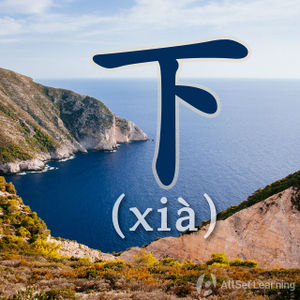Expressing location with "zai... shang / xia / li"
-
Level
-
Similar to
-
Used for
-
Keywords
You can use 在 (zài) to express location, but this article will explain how to use 在 (zài) to express location in relation to another object. This way, you can describe if something is "on the table" or "in the room".
Contents
在 with "Big Locations"
If you're talking about a "big place," like a country or city, then all you need is 在 (zài) and the name of the place.
Structure
在 + Place
Examples
For example, these phrases are fine just as they are:
- 在 中国 in China
- 在 美国 in the USA
- 在 上海 in Shanghai
- 在 纽约 in New York
You wouldn't want to add other words to the ends of these place names.
在 with Specific Locations
To show where an object is in relation to another object, make a "sandwich" starting with 在 (zài), then adding a place, and then following it with one of the following words: 上 (shàng), 下 (xià), 里 (lǐ), 旁边 (pángbiān).
Structure
在 + Place + 上 / 下 / 里 /旁边 / etc.
Notice that the "preposition" comes after the location and object that it modifies. That is, in English we say "on the table," but in Chinese, it is more like "at the table, on." This can be somewhat confusing, but don't worry. Once you start using this construction, it gets easy really quickly.
Note: if the 在 (zài) + Location + 上 (shàng) /下 (xià) / 里 (lǐ) / 旁边 (pángbiān) / etc. structure is placed in the middle of the sentence, as a subject, then the character 在 (zài) must be used. If the 在 (zài) + Location + 上 (shàng) / 下 (xià) / 里 (lǐ) / 旁边 (pángbiān) / etc. structure is placed at the beginning of the sentence, then the 在 (zài) can be omitted.
Examples
- 我 在 火车 上。 I am on the train.
- 他 在 楼 下。 He is downstairs.
- Walmart 在 我家 旁边。 Walmart is next to my house.
- 你 的 手机 在 包 里吗? Is your cell-phone in the bag?
- ( 在)地铁 上 有 很 多 人。 On the metro there are a lot of people.
Common Nouns of Locality
The little words that come after the location in the phrases above aren't really "prepositions." They are called "nouns of locality," or 方位词 (fāngwèicí) in Chinese. They actually tend to have several forms, which can be confusing if you're not used to them. The chart below shows their most common forms:
| One-Character | Two-Character | English |
|---|---|---|
| 上 | 上面 / 上边 | top, above |
| 下 | 下面 / 下边 | bottom, under |
| 里 | 里面 / 里边 | inside |
| 外 | 外面 / 外边 | outside |
| 边 | 旁边 | side, beside |
| 前 | 前面 / 前边 | front |
| 后 | 后面 / 后边 | back, behind |
| 左 | 左边 | left |
| 右 | 右边 | right |
Abstract Uses
Some prepositions can be paired with more abstract concepts to form idiomatic phrases. These kinds of phrases can really make your Chinese sound polished. Learn more about this construction here: Idiomatic phrases with "zai"
See Also
- Indicating location with "zai" before verbs
- Special cases of "zai" following verbs
- Expressing existence in a place with "zai"
Sources and Further Reading
Books
- Integrated Chinese: Level 1, Part 1 (3rd ed) (p. 128) →buy
- Integrated Chinese: Level 2, Part 1 (p. 191) →buy
- Integrated Chinese: Level 2, Part 2 (pp. 264, 325)→buy
- New Practical Chinese Reader 4 (新实用汉语课本4) (pp. 40-1, 164-5, 185) →buy



